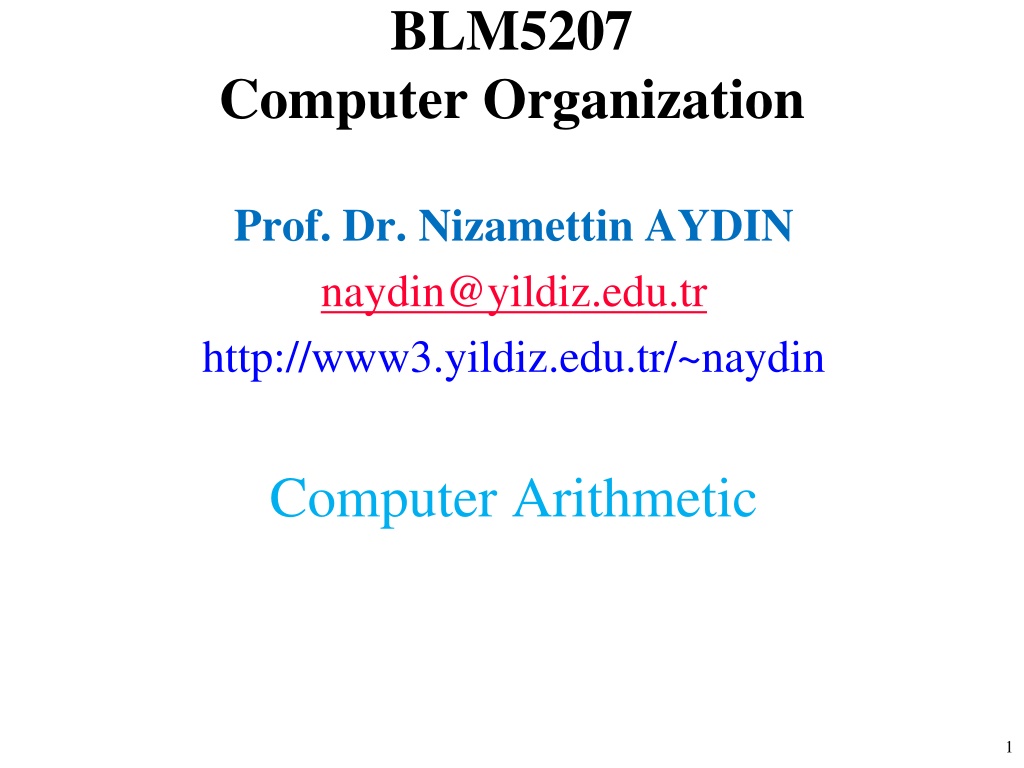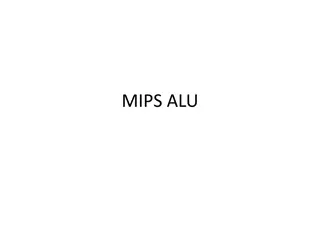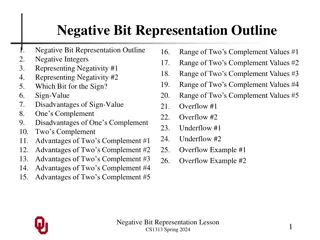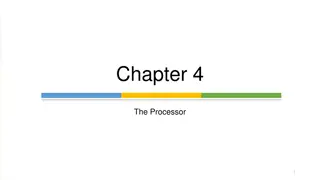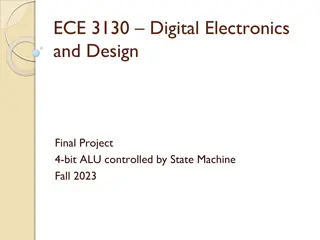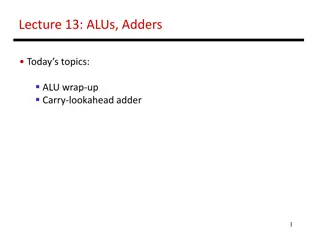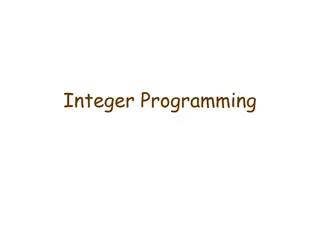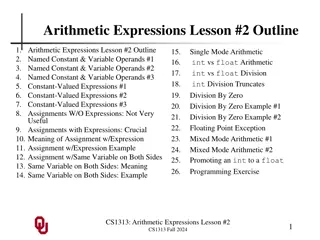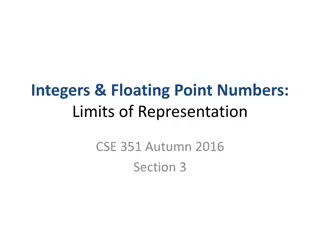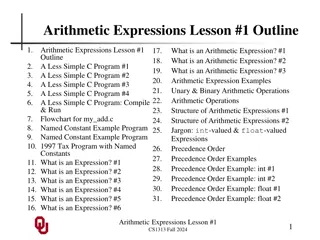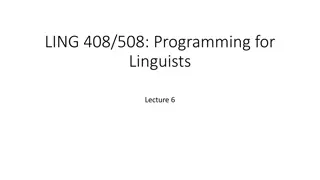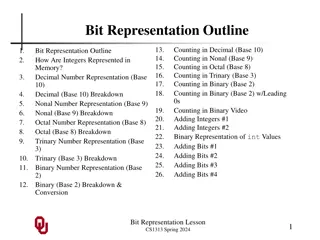Understanding Computer Arithmetic: ALU, Integer Representation, and Twos Complement
Exploring the fundamental concepts of computer arithmetic including the Arithmetic & Logic Unit (ALU), integer representation methods, and the Twos Complement system. Learn about sign-magnitude, characteristics of Twos Complement representation, benefits, negation techniques, and special cases in computer arithmetic.
Download Presentation

Please find below an Image/Link to download the presentation.
The content on the website is provided AS IS for your information and personal use only. It may not be sold, licensed, or shared on other websites without obtaining consent from the author. Download presentation by click this link. If you encounter any issues during the download, it is possible that the publisher has removed the file from their server.
E N D
Presentation Transcript
BLM5207 Computer Organization Prof. Dr. Nizamettin AYDIN naydin@yildiz.edu.tr http://www3.yildiz.edu.tr/~naydin Computer Arithmetic 1
Arithmetic & Logic Unit Does the calculations Everything else in the computer is there to service this unit Handles integers May handle floating point (real) numbers May be separate FPU (maths co-processor) May be on chip separate FPU (486DX +) 2
Integer Representation Only have 0 & 1 to represent everything Positive numbers stored in binary e.g. 41=00101001 No minus sign No period Sign-Magnitude Two s complement 4
Sign-Magnitude Left most bit is sign bit 0 means positive 1 means negative +18 = 00010010 -18 = 10010010 Problems Need to consider both sign and magnitude in arithmetic Two representations of zero (+0 and -0) 2 n i = i 2 if 0 a a 1 i n = = i A 0 2 n = i 2 if 0 a a 1 i n = 0 5
Twos Complement +3 = 00000011 +2 = 00000010 +1 = 00000001 +0 = 00000000 -1 = 11111111 -2 = 11111110 -3 = 11111101 2 n = i + 1 n i 2 2 a a 1 n i 0 6
Characteristics of Twos Complement Representation and Arithmetic 7
Benefits One representation of zero Arithmetic works easily (see later) Negating is fairly easy 3 = 00000011 Boolean complement gives Add 1 to LSB 11111100 11111101 8
Negation Special Case 1 0 = 00000000 Bitwise not 11111111 Add 1 to LSB +1 Result 1 00000000 Overflow is ignored, so: - 0 = 0 9
Negation Special Case 2 -128 = 10000000 bitwise not 01111111 Add 1 to LSB +1 Result 10000000 So: -(-128) = -128 X Monitor MSB (sign bit) It should change during negation 10
Range of Numbers 8 bit 2s complement +127 = 01111111 = 27-1 -128 = 10000000 = -27 16 bit 2s complement +32767 = 011111111 11111111 = 215- 1 -32768 = 100000000 00000000 = -215 11
Conversion Between Lengths Positive number pack with leading zeros +18 = 00010010 +18 = 00000000 00010010 Negative numbers pack with leading ones -18 = 10010010 -18 = 11111111 10010010 i.e. pack with MSB (sign bit) 12
Fixed-Point Representation Number representation discussed so far also referred as fixed point. Because the radix point (binary point) is fixed and assumed to be to the right of the rightmost digit (least significant digit). 13
Integer Arithmetic Negation: In sign magnitude, simply invert the sign bit. In twos complement: Apply twos complement operation (take bitwise complement including sign bit, and add 1) 14
Addition and Subtraction Normal binary addition Monitor sign bit for overflow Take twos complement of subtrahend and add to minuend i.e. a - b = a + (-b) So we only need addition and complement circuits 15
Addition and Subtraction Overflow rule If two numbers are added and they are both positive or both negative, then overflow occurs if and only if the result has the opposite sign Subtraction rule To subtract one number(subrahend) from another (minuhend), take twos complement (negation) of the subtrahend and add it to the minuhend 16
Addition of Numbers in Twos Complement Representation 17
Subtraction of Numbers in Twos Complement Representation (M S) 18
Multiplication Complex Work out partial product for each digit Take care with place value (column) Add partial products 20
Multiplication Example 1011 Multiplicand (11 dec) x 1101 Multiplier (13 dec) 1011 Partial products 0000 Note: if multiplier bit is 1 copy 1011 multiplicand (place value) otherwise zero 1011 10001111 Product (143 dec) Note: need double length result 21
Flowchart for Unsigned Binary Multiplication 24
Multiplying Negative Numbers This does not work! Solution 1 Convert to positive if required Multiply as above If signs were different, negate answer Solution 2 Booth s algorithm 25
Division More complex than multiplication Negative numbers are really bad! Based on long division 28
Division of Unsigned Binary Integers Quotient 00001101 10010011 1011 001110 1011 1011 Divisor Dividend Partial Remainders 001111 1011 Remainder 100 29
Example 31
Real Numbers Numbers with fractions Could be done in pure binary 1001.1010 = 24+ 20+2-1+ 2-3 =9.625 Where is the binary point? Fixed? Very limited Moving? How do you show where it is? 32
123 000 000 000 000 1.23 X 1014 0.0000000000000123 1.23 X 10-14 33
Floating Point +/- .significand x 2exponent Misnomer Point is actually fixed between sign bit and body of mantissa Exponent indicates place value (point position) 34
Signs for Floating Point Mantissa is stored in 2s complement Exponent is in excess or biased notation e.g. Excess (bias) 128 means 8 bit exponent field Pure value range 0-255 Subtract 128 to get correct value Range -128 to +127 36
Normalization FP numbers are usually normalized i.e. exponent is adjusted so that leading bit (MSB) of mantissa is 1 Since it is always 1 there is no need to store it (c.f. Scientific notation where numbers are normalized to give a single digit before the decimal point e.g. 3.123 x 103) 37
FP Ranges For a 32 bit number 8 bit exponent +/- 2256 1.5 x 1077 Accuracy The effect of changing lsb of mantissa 23 bit mantissa 2-23 1.2 x 10-7 About 6 decimal places 38
IEEE 754 Standard for floating point storage 32 and 64 bit standards 8 and 11 bit exponent respectively Extended formats (both mantissa and exponent) for intermediate results 41
Interpretation of IEEE 754 Floating-Point Numbers 44
Floating-Point Numbers and Arithmetic Operations 45
A floating-point operation may produce one of these conditions: Exponent overflow: A positive exponent exceeds the maximum possible expo-nent value. In some systems, this may be designated as + or . Exponent underflow: A negative exponent is less than the minimum possible exponent value (e.g., 200 is less than 127). This means that the number is too small to be represented, and it may be reported as 0. Significand underflow: In the process of aligning significands, digits may flow off the right end of the significand. Some form of rounding is required. Significand overflow: The addition of two significands of the same sign may result in a carry out of the most significant bit. This can be fixed by realignment. 46
FP Arithmetic +/- Check for zeros Align significands (adjusting exponents) Add or subtract significands Normalize result 47
FP Arithmetic +/- Phase 1 Zero check Because addition and subtraction are identical except for a sign change, the process begins by changing the sign of the subtrahend if it is a subtract operation. Next, if either operand is 0, the other is reported as the result. 48
FP Arithmetic +/- Phase 2 Significand alignment Numbers needs to be manipulated so that the two exponents are equal. To see the need for aligning exponents, consider the following decimal addition: (123 x 100) + (456 x 10-2) Clearly, we cannot just add the significands. The digits must first be set into equivalent positions, that is, the 4 of the second number must be aligned with the 3 of the first. Under these conditions, the two exponents will be equal,which is the mathematical condition under which two numbers in this form can be added. Thus, (123 x 100) + (456 x 10-2) = (123 x 100) + (4.56 x 100) = 127.56x100 49
FP Arithmetic +/- Phase 2 Alignment may be achieved by shifting either the smaller number to the right (increasing its exponent) or shifting the larger number to the left. Because either operation may result in the loss of digits, it is the smaller number that is shifted; any digits that are lost are therefore of relatively small significance. The alignment is achieved by repeatedly shifting the magnitude portion of the significand right 1 digit and incrementing the exponent until the two exponents are equal. (Note that if the implied base is 16, a shift of 1 digit is a shift of 4 bits.) If this process results in a 0 value for the significand, then the other number is reported as the result. Thus, if two numbers have exponents that differ significantly, the lesser number is lost. 50
